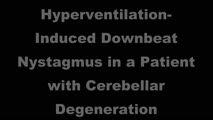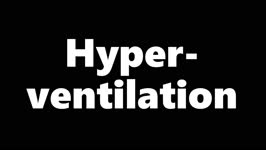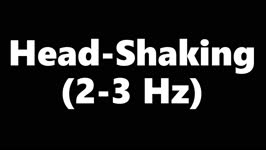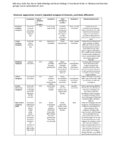A collection of videos relating to the diagnosis and treatment of eye movement disorders. This collection includes many demonstrations of examination techniques.
Dan Gold, D.O., Associate Professor of Neurology, Ophthalmology, Neurosurgery, Otolaryngology - Head & Neck Surgery, Emergency Medicine, and Medicine, The Johns Hopkins School of Medicine.
A collection of videos relating to the diagnosis and treatment of eye movement disorders.
NOVEL: https://novel.utah.edu/
TO
Filters: Collection: ehsl_novel_gold
1 - 25 of 16
| Title | Description | Subject | ||
|---|---|---|---|---|
| 1 |
 |
Hyperventilation-Induced Downbeat Nystagmus in a Cerebellar Disorder | 𝗢𝗿𝗶𝗴𝗶𝗻𝗮𝗹 𝗗𝗲𝘀𝗰𝗿𝗶𝗽𝘁𝗶𝗼𝗻: This is a 45-year-old woman with a chronic progressive cerebellopathy of unclear etiology (worsening over at least 10 years) characterized by gait and limb ataxia, gaze-evoked nystagmus, saccadic pursuit and vestibulo-ocu... | Hyperventilation; Jerk Nystagmus; Downbeat Nystagmus; Downbeat Nystagmus; Cerebellar Pathology |
| 2 |
 |
Hyperventilation | Hyperventilation: instruct the patient to breathe rapidly in and out of their mouth for 40-60 seconds. Alkalosis and changes in ionized calcium may improve conduction through an affected segment of 8th cranial nerve due to vestibular schwannoma (https://collections.lib.utah.edu/details?id=1213447) o... | Hyperventilation |
| 3 |
 |
Assessing for Hyperventilation-induced Nystagmus | 𝗢𝗿𝗶𝗴𝗶𝗻𝗮𝗹 𝗗𝗲𝘀𝗰𝗿𝗶𝗽𝘁𝗶𝗼𝗻: Hyperventilation induced nystagmus is tested by asking the patient to take quick deep breaths (~1/s) for 40-60 seconds. This decreases ICP and increases CSF pH. This can be helpful in diagnosing irritative conditions of ... | Hyperventilation |
| 4 |
 |
Vibration and Hyperventilation-induced Nystagmus from Vestibular Schwannoma | 𝗢𝗿𝗶𝗴𝗶𝗻𝗮𝗹 𝗗𝗲𝘀𝗰𝗿𝗶𝗽𝘁𝗶𝗼𝗻: This is a 50-yo-woman with imbalance, and with fixation removed on her examination (with Frenzel goggles), there was no spontaneous nystagmus. Using a handheld vibrator to vibrate the mastoids and vertex, there was a righ... | Jerk Nystagmus; Vestibular Nystagmus; Hyperventilation |
| 5 |
 |
Downbeat Nystagmus with Active Horizontal Head Shaking | This is a 70-year-old man who presented with one single complaint for 10 years - if he moved his head too quickly (even one single horizontal head movement to the right or the left), he would experience the abrupt loss of balance and dizziness. His typical episodes were reproducible, and interesting... | Downbeat Nystagmus; Jerk Nystagmus; OMS Cerebellar; Abnormal Headshaking; Gaze-Evoked Nystagmus |
| 6 |
 |
The Virtual (Telemedicine) Vestibular Examination | 𝗢𝗿𝗶𝗴𝗶𝗻𝗮𝗹 𝗗𝗲𝘀𝗰𝗿𝗶𝗽𝘁𝗶𝗼𝗻: This document is based on Approach to the Ocular Motor & Vestibular History and Examination: https://collections.lib.utah.edu/ark:/87278/s64x9bq1, but adapted and edited for the telemedicine exam. Virtual vestibular ex... | Saccades; Ocular Stability; Vestibular Examination |
| 7 |
 |
Upbeat and Downbeat Nystagmus Due to Anti-VGCC Antibodies | Seen here are two patients who presented with imbalance and vertical oscillopsia, the first with upbeat nystagmus, and the second with downbeat nystagmus. Both patients were found to have voltage-gated calcium channel antibodies in serum without evidence of systemic malignancy. The UBN patient had m... | Jerk Nystagmus; Upbeat Nystagmus; Gaze Evoked Nystagmus; Downbeat Nystagmus |
| 8 |
 |
Head-Shaking-Induced Nystagmus Following Ramsay Hunt Vestibulopathy | 𝗢𝗿𝗶𝗴𝗶𝗻𝗮𝗹 𝗗𝗲𝘀𝗰𝗿𝗶𝗽𝘁𝗶𝗼𝗻: This is a 50-year-old man who experienced the abrupt onset of imbalance, dizziness and left-sided hearing loss 4 months prior to this examination. He was found to have herpetic vesicles in the left external auditory canal... | Vestibular Nystagmus; Head-Shaking; Jerk Nystagmus; Vestibularcochlear; Acute Vestibular Syndrome |
| 9 |
 |
Head-Shaking (2-3 Hz) | Head-shaking: instruct the patient to close their eyes and perform active rapid head-shaking at 2-3 Hz for ~15 secs. If a unilateral vestibulopathy is present, head-shaking-induced (contralesional) nystagmus is often provoked, with the slow phase toward the affected ear. With central lesions, the ny... | Head-Shaking (2-3 Hz) |
| 10 |
 |
The Most Common Audiovestibular Laboratory Tests, and the Specific Conditions in Which They May Assist in Making or Supporting the Diagnosis | VN = vestibular neuritis; VM = vestibular migraine; VP = vestibular paroxysmia; vHIT = video head impulse test; VNG = video-nystagmography; ENG = electronystagmography; VOG = video-oculography; VEMPs = vestibular evoked myogenic potentials; SCDS = superior canal dehiscence syndrome; BPPV = benign pa... | Vestibular Examination; Vestibular Lab Testing |
| 11 |
 |
The Most Common Vestibular Conditions Categorized by Timing and Triggers, with Specific Ocular Motor and Vestibular Features that Should be Sought for Each | HINTS+ = Head Impulse, Nystagmus, Test of Skew, ‘Plus' bedside assessment of auditory function; HIT = head impulse test; NP = nerve palsy; BPPV = benign paroxysmal positional vertigo; SCDS = superior canal dehiscence syndrome; BVL = bilateral vestibular loss; PPPD = persistent postural perceptual ... | Vestibular Examination |
| 12 |
 |
The Episodic Vestibular Syndrome | This is a 55-year-old man with 6 months of episodic vertigo without clear triggers/provocative factors, with each of his 3 previous episodes lasting less than 5 minutes. While in the clinic, he had one of his typical vertigo attacks. There was initially 30 seconds of right-beating-torsional nystagmu... | Jerk Nystagmus; Acute Vestibular Syndrome |
| 13 |
 |
ENG, VNG, & VOG | 𝗢𝗿𝗶𝗴𝗶𝗻𝗮𝗹 𝗗𝗲𝘀𝗰𝗿𝗶𝗽𝘁𝗶𝗼𝗻: Electronystagmography (ENG), and videonystagmography (VNG) or videooculography (VOG) are a collection of tests of eye movements that are performed either using surface electrodes around the eye (ENG) or with video goggles... | Vestibular Lab Testing; ENG, VNG, & VOG |
| 14 |
 |
Approach to the Ocular Motor and Vestibular History and Examination | History and examination of ocular motor and vestibular. | Saccades; Ocular Stability; Vestibular Examination |
| 15 |
 |
The Virtual (Telemedicine) Ocular Motor Examination | 𝗢𝗿𝗶𝗴𝗶𝗻𝗮𝗹 𝗗𝗲𝘀𝗰𝗿𝗶𝗽𝘁𝗶𝗼𝗻: This document is based on Approach to the Ocular Motor & Vestibular History and Examination: https://collections.lib.utah.edu/ark:/87278/s64x9bq1, but adapted and edited for the telemedicine exam. Virtual Ocular Motor Ex... | Saccades; Ocular Stability; Vestibular Examination |
| 16 |
 |
Expanded Nystagmus & Saccadic Intrusions/Oscillations Differential | Expanded nystagmus & saccadic intrusions/ oscillations differential |
1 - 25 of 16
